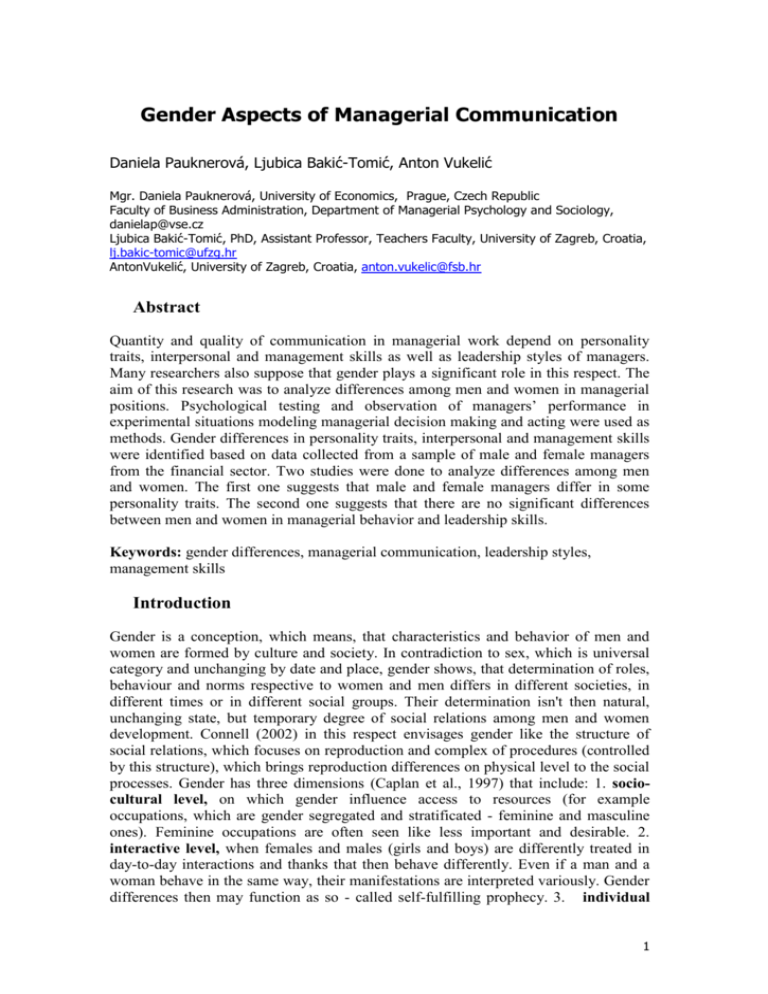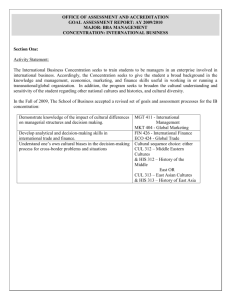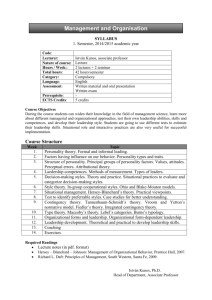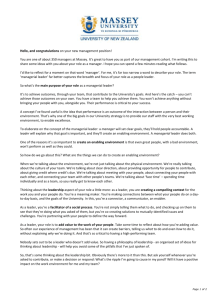Gender Aspects of Managerial Communication
advertisement

Gender Aspects of Managerial Communication Daniela Pauknerová, Ljubica Bakić-Tomić, Anton Vukelić Mgr. Daniela Pauknerová, University of Economics, Prague, Czech Republic Faculty of Business Administration, Department of Managerial Psychology and Sociology, danielap@vse.cz Ljubica Bakić-Tomić, PhD, Assistant Professor, Teachers Faculty, University of Zagreb, Croatia, lj.bakic-tomic@ufzg.hr AntonVukelić, University of Zagreb, Croatia, anton.vukelic@fsb.hr Abstract Quantity and quality of communication in managerial work depend on personality traits, interpersonal and management skills as well as leadership styles of managers. Many researchers also suppose that gender plays a significant role in this respect. The aim of this research was to analyze differences among men and women in managerial positions. Psychological testing and observation of managers’ performance in experimental situations modeling managerial decision making and acting were used as methods. Gender differences in personality traits, interpersonal and management skills were identified based on data collected from a sample of male and female managers from the financial sector. Two studies were done to analyze differences among men and women. The first one suggests that male and female managers differ in some personality traits. The second one suggests that there are no significant differences between men and women in managerial behavior and leadership skills. Keywords: gender differences, managerial communication, leadership styles, management skills Introduction Gender is a conception, which means, that characteristics and behavior of men and women are formed by culture and society. In contradiction to sex, which is universal category and unchanging by date and place, gender shows, that determination of roles, behaviour and norms respective to women and men differs in different societies, in different times or in different social groups. Their determination isn't then natural, unchanging state, but temporary degree of social relations among men and women development. Connell (2002) in this respect envisages gender like the structure of social relations, which focuses on reproduction and complex of procedures (controlled by this structure), which brings reproduction differences on physical level to the social processes. Gender has three dimensions (Caplan et al., 1997) that include: 1. sociocultural level, on which gender influence access to resources (for example occupations, which are gender segregated and stratificated - feminine and masculine ones). Feminine occupations are often seen like less important and desirable. 2. interactive level, when females and males (girls and boys) are differently treated in day-to-day interactions and thanks that then behave differently. Even if a man and a woman behave in the same way, their manifestations are interpreted variously. Gender differences then may function as so - called self-fulfilling prophecy. 3. individual 1 level, men and women accept gender differences as part of a self-conception. On this level gender is regarded as dichotomic – person can be a man or a women. 1. Theoretical backround Although psychological gender differences have been searched since the beginning of the formalized psychology (1879), researchers are not consistent in this topic. Definite differences are found concerning anatomical and functional specificity of men and women brains. Many scientists in this respect agree that during any activities women activate more parts of brains than men. Women have more connected hemispheres and therefore use emotions more than men and mix them with analytical thinking. Thanks that they are more sensitive to nonverbal behavior, especially to mimic expressions (Moir and Jessel, in Butler – Bowdon, 2007). Traditionally men are considered being more aggressive, better in spatial orientation and mathematical abilities. However nowadays more researchers argue, see e.g . Basow (1986), Oakley (2000) or Caplan et al. (1997), that in most personality dimensions there are bigger differences interindividual than intersexual. Last studies show, that men and women are getting more and more alike. For example, Twenge (2001) found out no gender differences in assertiveness, Hyde (2005) in her large meta-analytical study found significant dissimilarities only in motor performance (throwing to the distance), further in some aspects of sexuality and in aggressiveness. Cross - cultural research reflects differences in conception of gender roles in different cultures. Hofstede (1998) differs so called masculine and feminine cultures. While in masculine cultures men should be assertive, determined, tough and have material success, women are expected to be modest, gentle and oriented on quality of life. In feminine cultures being modest, gentle and focused on quality of life is expected from women as well as men. Highly masculine cultures are for example: Japan, Austria, Venezuela, Italy, Switzerland, Mexico, Great Britain, Germany, USA and Australia, (also Czech Republic – Novy, 1996). Denmark, Holland, Norway and Sweden belong to feminine cultures (Hofstede, 1998). Newly these results have been verified for example by Sczesny, Bosak, Neff, Schyns (2004). In different cultures different approaches are applied to women in management. While in masculine cultures women are forced to conform to masculine behavioral patterns, in feminine cultures it is not required. In this respect it is also interesting that in masculine cultures gender differences are exaggerated. The growing impact of women in the workforce continues to stimulate research on the leadership style of women. An ongoing debate exists in the management literature whether female and male managers differ in leadership styles and communication with their subordinates. Some researchers argue that women and men differ in leadership styles - men use more directive, so - called transactional managerial style, characterized by using of orders, rewards behind desirable, and especially penalties behind undesirable behaviour, while women tend to use transformational leadership style (Bass et al., 1996, Rosener, 1990, 1995). This leadership style is characteristic for managers, who focus on relationships, motivation of subordinates, trust, communication and shared vision. Leaders motivate subordinates by explanation of purpose and meaning of their work, counsel and help them. Other researchers suggest that transformational style does not depend on gender (Mandell and Pherwani, 2003). 2 For example Bass (1997) found out that transformational leaders are more successful than transactional leaders. Transformational style is at the same time regarded not only as the most effective style from the subordinates point of view, but has also positive influence on productivity and financial results of organization (Burke,Collins, 2001). Helgesen (1990) suggests that women managers appreciate, in contradiction to men managers, cooperation and relationships and prefer organizational structure in form of network rather than conventional hierarchical structures, male managers are more oriented on task, hierarchical structure and power. Some researchers assume that feminine characteristics are advantage for leadership. These characteristics support communication competence (especially listening ability and empathy). Advanced negotiation skills (negotiation and solving conflicts) as well as advanced interpersonal skills and sensitive access to people belong to them (Stanford, Oates, Flores 1995). Kabacoff (in Claes, 1999) found out that women are considered as better in empathy and in communication than men. However similar number of researchers argues that women and men managers do not differ in leadership styles and managerial skills (Hyde, 2005, Eagley et al., 1992, 2003, Vilkinas, 2000, Wajcman, 1996). 2. Research questions, sample, variables, methods The aim of this research was to analyze differences among men and women in managerial positions. This research addresses the following research questions: Do gender differences exist in personality traits of managers? Are there gender differences in managerial communication and skills? Two independent studies were done to analyze differences among men and women in managerial positions. In the first one we tried to find out if male and female managers differ in some personality traits. We used as a method personality questionnaire of Czech origin (IHAVEZ). Gender differences in personality traits, interpersonal and management skills were identified based on data collected from a sample of male and female managers from the financial sector. in sum men women gender abs. rel.% abs. rel.% abs. rel.% 405 100,00 261 64,44 144 35,56 to 30 31- 45 46 and more age abs. rel.% abs. rel.% abs. rel.% 140 34,57 210 51,85 55 13,58 We analyze following personality characteristics: level of stimulation, risk taking, personal integrity, aspiration level, need to assert oneself, self-confidence, responsibility and masculinity/femininity dimension. In the second study we observe managers´ performance in experimental situations modeling managerial decision making and acting. We use only a part of the same sample: in sum men women gender abs. rel.% abs. rel.% abs. rel.% 241 100,00 150 62,24 91 37,76 3 to 30 31- 45 46 and more age abs. rel.% abs. rel.% abs. rel.% 78 32,37 133 55,19 30 12,44 Therefore results from observation do not quite correspond with analysis of personality dimensions, it is not possible to compare them and we work with them as with two independent studies. We observed following characteristics: assertiveness, managerial skills, communication skills, stress tolerance and authority. 1. assertiveness – self promotion and open communication of opinions, 2. managerial skills – activity in problem solving situations, organizational and leadership skills, 3. communication skills - presentational skills, motivation of subordinates, persuasive abilities, 4. stress tolerance – self-confidence, absence of nervousness, 5. authority – charisma, leading figure. 3. Research results and discussion The findings of the first study suggest that female and male managers differ in certain personality traits (N.S. means no significant difference): Personality characteristics T-test Results level of stimulation t = 4,28465, p < 0,05 men are more stimulated risk taking t = 4,2603, p < 0,05 men are more prone to risk taking personal integrity t = 0,889382, p > 0,05 N.S. aspiration level t = 4,57296, p < 0,05 men have higher aspirations need to assert oneself t=3, 99197, p < 0,05 men are more prone to assert themselves self-confidence t=-0,814271, p > 0,05 N.S. responsibility t=0,904207, p > 0,05 N.S. t = -0,416901, p > 0,05 N.S. femininity/masculinity Male managers are more stimulated, have higher aspirations, are more prone to taking risk and are more oriented on self-assertion than female managers. These facts can be determined by masculinity of our culture as well as demands of gender roles. Female and male managers do not differ in personal integrity, self-confidence, responsibility and in masculinity/femininity dimension. When we compared personality profiles of female managers with the population of common women we found out that they differ more from the common female population than from male managers. The results of the second study – observation of managers in situations modeling managerial decision making and acting - suggest that there are no significant gender differences in observed characteristics. 4 Observed characteristics T-test Results assertiveness t = 0,837835, p > 0,05 t = -0,427169, p > 0,05 t = 0,078686, p > 0,05 t = -0,462274, p > 0,05 t = 1,70713, p > 0,05 N.S. managerial skills communication skills stress tolerance authority N.S. N.S. N.S. N.S. These findings indicate that managers are a specific group of people who are stable, self-confident, responsible and rather masculine. These findings can be also determined by the fact that female managers often adopt masculine behavior patterns in masculine cultures. Our results are of course limited by a specific branch – it would be inappropriate to conclude that we can generalize these findings to all women in management. However our study provided further evidence that female and male managers are more alike than different. This fact can have the adverse effect that women, in effort to succeed in masculine management environment, take over masculine patterns exceedingly and do not used softer feminine tactics and policy. Nevertheless today´s organizations need managers who can develop positive relationship with subordinates, persuade them and motivate them to look beyond their own needs on the interests of the whole group. It raises some questions for future research – Do female managers from other branches differ? Is their behavior influenced by adoption of masculine behavior patterns and to what extent? Are female managers more transformational than male managers? Will the increasing number of female managers determine change of leadership styles and communication or not? 4. References Bass,B.M., Avolio,B.J., Atwater,L.: The transformational and transactional leadership for men and women. Applied Psychology: An International Review, 45/1, 1996, 5-34 Bass, B.M.: Does the transactional-transformational leadership paradigma transcend organizational and national boundaries? American Psychologist, 52, 1997, 130-139 Basow,S.A.: Gender stereotypes (traditions and perspective). Monterey, Brooks/Cole Publishing Company, 1986 Burke,S. – Collins,K.M.: Gender differences in leadership styles and management skills. Women in Management Review, 16/5, 2001, 244-256 Butler – Bowdon,T.: 50 Psychology Classics. London, Nicholas Brealey Publishing, 2007 Caplan, P.J., Crawford,M., Hyde, J.S., Richardson, J.T.E.: Gender Differences in Human Cognition. Oxford, Oxford University Press, 1997 Claes,M.T.: Women, men and management styles. International Labour Review , 138/4, 1999, 431-46 Connell, R.W.: Gender. Cambridge, Polity Press, 2002 Eagly,A.H., Makhijani,M.G.,Klonsky,B.G.: Gender and the evaluation of leaders: A meta – analysis. Psychological Bulletin, 111, 1992, 3-22 Eagly,A.H., Johannesen-Schmidt,M.C. and van Engen,M.L.: Transformational, transactional and laissez-faire leadership styles: A meta-analysis comparing women and men. Psychological Bulletin, 117, 125-145. Helgesen, S.: The Female Advantage: Women’s Ways of Leadership, Doubleday/Currency, New York, NY., 1990 Hofstede,G. et al.: Masculinity and Femininity. London, Sage publ., 1998 Hyde,J.S.: The Gender Similarities Hypothesis. American Psychologist, vol. 60/6, 2005, 581-592 Nový,I. a kol.: Interkulturální management. Praha, Grada, 1996 Oakley, A.: Pohlaví, gender a společnost. Praha, Portál, 2000 Powell,G.N.: Handbook of Gender and Work. London, Sage publ., 1999 Rosener,J.B.: Ways Women lead. Harvard Business Review. 68, 1990, s. 119-25 Rosener,J.B.: America´s Competitive Secret: Utilizing Women as a Management Strategy. Oxford University Press, N.Y. 1995 5 Schein , V.E., Mueller, R., Lituchy, T. and Liu, J. : Think manager - think male: a global phenomenon?’’, Journal of Organizational Behavior, 17, 1996, s. 33-41 Sczesny,S., Bosak, J., Neff, D., Schyns,B.: Gender stereotypes and the Attribution of Leadership Traits: A Cross-Cultural Comparison. Sex Roles, 51-11/12, 2004 Stanford, Oates, Flores 1995 Vilkinas,T.: The gender factor in management: how significant others perceive effectiveness. Women in Management Review. 15/5,6, 2000 Wajcman,J.: Desperately seeking differences: is management style gendered?, British Journal of Industrial Relations, 14/3, 1996, s.333-49 6








